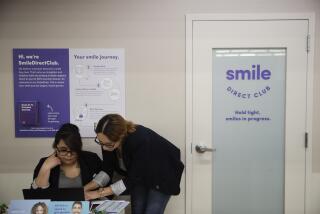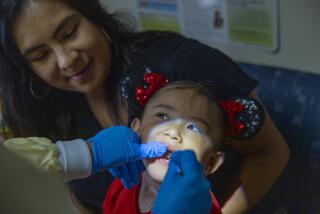Full-Metal Mouths
- Share via
Braces have long transcended adolescent geekdom to become “mouth jewelry,” “cool” and, claims a write-up in the twentysomething magazine Jane, “so human.”
In fact, in the past five years or so, when kids cried in the orthodontist’s chair, it wasn’t because they needed braces but because they didn’t.
“I’ve had kids be so disappointed when I tell them they have perfect teeth,” said Dr. Monica Cipes, a West Hartford, Conn., pediatric dentist.
Of course, around the time the distraught kids are dealing with that news, parents are usually breathing a sigh of relief--although, not necessarily for the reasons we might think.
An increasing number of adults are opening wide--mouths and wallets--for the once dreaded oral accessory that is now making its way onto many of their “to do” lists. (Hence, the sigh of relief at the prospect of financing one mouthful of braces rather than two.)
Well-known adults have worn braces: Cher, Diana Ross and Phyllis Diller.
There’s also a commercial that features steely grinned Green Bay Packers quarterback Brett Favre touting the benefits of orthodontia.
And check this out: Where once only flawless beauty ruled, metal-mouthed models are increasingly showing off their glittering grins in fashion magazines and on runways.
Agatha (“just Agatha”) is one of at least four up-and-coming models who seem to be turning orthodontia into a status symbol of sorts. Models Lucy Bower, Cordelia and Katie Black are others.
Discovered on a New York City street while running errands with her mother, the 16-year-old from New Jersey said she worried that she would be rejected because she wore braces.
“But the model scout made me feel so comfortable with the braces,” said Agatha, who had them put on a year ago to line up her teeth. “She actually liked them.”
And why not? In an industry always looking to set their divas apart (Read: Cindy Crawford’s mole), braces seem to be the next new fashion thing.
“It’s funny. Like in the beginning I was really nervous,” Agatha said. “I thought, ‘Oh, my God, what are the photographers going to think?’ But they tell me to smile.”
Although having modeled for only a few months, Agatha and her braces have been featured in such magazines as Marie Claire and Jane.
*
Back in the real world--OK, our real world--Dr. Elena-lee Ritoli is tending to Lori Dumont’s braces in her West Hartford office.
“These are going to feel sore,” Ritoli tells Dumont while she tightens and changes brackets and wires.
“So, should I put the steak back in the freezer?” asks Dumont .
“No,” Ritoli says, laughing. “You should be all right for dinner.”
Dumont, who is 35 and who got her braces about two years ago, is one of nearly 1 million adults in the United States who wears braces. While men are increasingly seeking better smiles through braces, 70% of adult wearers are women.
“That’s one out of four orthodontic patients, double what it was 10 years ago,” said Pam Paladin, of the American Assn. of Orthodontics.
Connecticut area orthodontists report from 25% to 50% of their clients are adults. Ritoli, who has an 84-year-old patient with retainers, said 50% of hers are adults.
Reasons for the increase, said Dr. Louis Norton, professor emeritus at University of Connecticut’s School of Dental Medicine, range from economics to technology. Tin grins now have a lot less tin in them, and 100 million Americans now have dental insurance, with an increasing number of companies offering some type of orthodontic coverage.
The options seem endless: Wearers can get clear or neutral-colored brackets. Lingual braces, which are applied to the inside teeth surfaces, are available. Rubber bands can be color-coordinated to seasons, orange and black for Halloween, red and green for Christmas.
While children seem to favor the colors and funkier styles (Jacquelyn Matava, 10, had black rubber bands inserted for Halloween and her Grim Reaper costume), adults prefer a more subtle approach.
Carlos Rivera, a 31-year-old therapist, chose clear braces for his top teeth, though he had them temporarily removed for his wedding in August.
“For the pictures,” he said, unapologetically.
*
With all the available options, adults whose parents couldn’t afford braces are now fixing things they always wanted to or correcting problems that developed as they matured.
“I used to always cover my mouth when I smiled,” said Dumont, whose family couldn’t afford to fix five mouthfuls of crooked teeth. “I still cover them because of the braces, but soon I won’t have to at all.”
Unlike Dumont, however, many adults are wearing braces for the second time around.
Deborah Matava, Jacquelyn’s mother, wore braces as a teen. As an adult, however, her bottom teeth began to shift and overcrowd, making proper cleaning difficult--something dentists said often happens with adults.
Happy with what Norton was doing with her daughter’s teeth, Matava, 42, decided to give braces another try.
“Sometimes, I feel like they are doing me more good this time around,” she said.
So, who’s the better patient--the child or the parent?
Orthodontists said both groups make good patients, although adults are more unlikely to chow down on a pack of Bubblicious gum.
“They’re different,” Ritoli said of adult and child patients. “While the adult might ask questions about the procedure, the child wants to know what color rubber bands she can get.”
Still, while attitudes about braces have changed, be warned: Some things haven’t.
Orthodontists said the price tag on braces haven’t really increased much over the years, but they are still expensive: anywhere from $1,500 to $4,500.
And while kids seem to have abandoned using the “metal mouth” and “train track” chants on each other, brace-faced adults aren’t yet exempt.
“Yeah, I have had a couple of my young clients call me ‘metal mouth,’ ” Rivera said. “But they seem to like making fun of my receding hairline more.”






